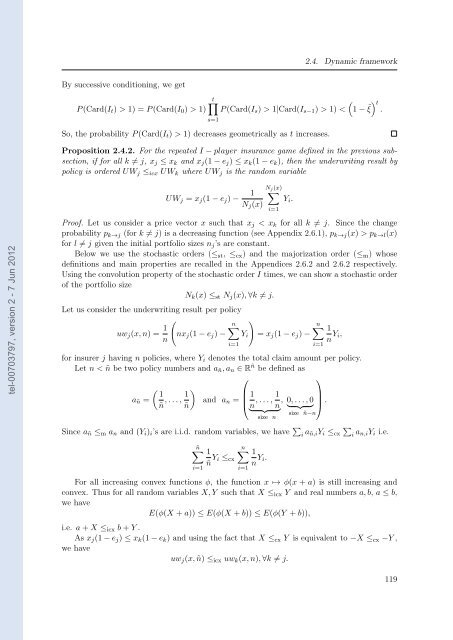Etude des marchés d'assurance non-vie à l'aide d'équilibres de ...
Etude des marchés d'assurance non-vie à l'aide d'équilibres de ...
Etude des marchés d'assurance non-vie à l'aide d'équilibres de ...
Create successful ePaper yourself
Turn your PDF publications into a flip-book with our unique Google optimized e-Paper software.
tel-00703797, version 2 - 7 Jun 2012<br />
By successive conditioning, we get<br />
P (Card(It) > 1) = P (Card(I0) > 1)<br />
t<br />
P (Card(Is) > 1|Card(Is−1) > 1) <<br />
So, the probability P (Card(It) > 1) <strong>de</strong>creases geometrically as t increases.<br />
s=1<br />
2.4. Dynamic framework<br />
<br />
1 − ˜ t ξ .<br />
Proposition 2.4.2. For the repeated I − player insurance game <strong>de</strong>fined in the previous subsection,<br />
if for all k = j, xj ≤ xk and xj(1 − ej) ≤ xk(1 − ek), then the un<strong>de</strong>rwriting result by<br />
policy is or<strong>de</strong>red UWj ≤icx UWk where UWj is the random variable<br />
UWj = xj(1 − ej) − 1<br />
Nj(x)<br />
<br />
Yi.<br />
Nj(x)<br />
Proof. Let us consi<strong>de</strong>r a price vector x such that xj < xk for all k = j. Since the change<br />
probability pk→j (for k = j) is a <strong>de</strong>creasing function (see Appendix 2.6.1), pk→j(x) > pk→l(x)<br />
for l = j given the initial portfolio sizes nj’s are constant.<br />
Below we use the stochastic or<strong>de</strong>rs (≤st, ≤cx) and the majorization or<strong>de</strong>r (≤m) whose<br />
<strong>de</strong>finitions and main properties are recalled in the Appendices 2.6.2 and 2.6.2 respectively.<br />
Using the convolution property of the stochastic or<strong>de</strong>r I times, we can show a stochastic or<strong>de</strong>r<br />
of the portfolio size<br />
Nk(x) ≤st Nj(x), ∀k = j.<br />
Let us consi<strong>de</strong>r the un<strong>de</strong>rwriting result per policy<br />
uwj(x, n) = 1<br />
<br />
n<br />
nxj(1 − ej) −<br />
n<br />
i=1<br />
Yi<br />
<br />
i=1<br />
= xj(1 − ej) −<br />
n<br />
i=1<br />
1<br />
n Yi,<br />
for insurer j having n policies, where Yi <strong>de</strong>notes the total claim amount per policy.<br />
Let n < ñ be two policy numbers and añ, an ∈ Rñ be <strong>de</strong>fined as<br />
⎛<br />
⎞<br />
<br />
1 1<br />
⎜<br />
añ = , . . . , and an = ⎜<br />
1 1 ⎟<br />
ñ ñ<br />
⎝ , . . . , , 0, . . . , 0 ⎟<br />
n n<br />
⎠<br />
size ñ−n<br />
size n<br />
.<br />
Since añ ≤m an and (Yi)i’s are i.i.d. random variables, we have <br />
i añ,iYi<br />
<br />
≤cx i an,iYi i.e.<br />
ñ<br />
i=1<br />
1<br />
ñ Yi ≤cx<br />
n<br />
i=1<br />
1<br />
n Yi.<br />
For all increasing convex functions φ, the function x ↦→ φ(x + a) is still increasing and<br />
convex. Thus for all random variables X, Y such that X ≤icx Y and real numbers a, b, a ≤ b,<br />
we have<br />
E(φ(X + a)) ≤ E(φ(X + b)) ≤ E(φ(Y + b)),<br />
i.e. a + X ≤icx b + Y .<br />
As xj(1 − ej) ≤ xk(1 − ek) and using the fact that X ≤cx Y is equivalent to −X ≤cx −Y ,<br />
we have<br />
uwj(x, ñ) ≤icx uwk(x, n), ∀k = j.<br />
119
















